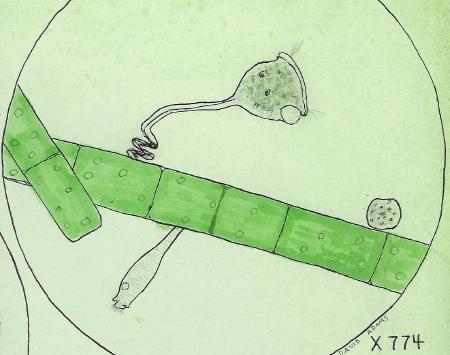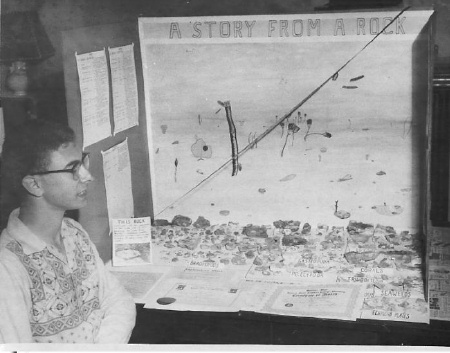Stories
The story of
the Stevenson family
My interest in science was aided at the age of 15 when I took biology as a sophomore in high school and my biology teacher, Mr Fryback, told me I could take one of the microscopes of the school to use at home. I became fascinated by the world of tiny plants and animals that could be found in a jar of pond water after it had matured for a while, and I began to draw and identify them.
This led to a project which I entered in a science fair in Pittsburg Kansas, a census of protozoa in the local fish hatchery over a few months. With the help of my art teacher, Maude Mary Wilson, who was a friend of the family, I painted scenes of what I say through the microscope (like the one shown below) and created a nice exhibit. If I recall correctly, I was the overall winner of the science fair even though most of the other contestants were older.

Protozoa: vorticella, amoeba and scyphidia, on green strand algae
Emboldened by the success in Kansas, I started a more elaborate project to enter in the National Science Talent Search. I had long collected fossils from the hillside behind our house. Now I chose a rather large rock to make an inventory of all the fossils it contained. This was a great success, as there were an amazingly large number of different and interesting species contained in the rock, many of which had been preserved in remarkably fine condition. And the red chert gave beautiful color to them as well.
Again, with the advice of my art teacher, I produced an overall painting that reconstructed the scene of the animals when they were still alive. I still keep the box of fossils and the painting that was the backdrop for the display.

Combined with my extraordinarily high test scores, the project won me a place among the finalists in the National Science Talent Search and the exhibit won me a place among the top finishers.
At that time I began to correspond with professional paleontologists and even described a new species of brachiopod from among my fossils. I can't find the correspondence, but according to my notes it was a new species of Setigerites which was to be described in the newest edition of Mackenzie Gordon and Muir-Wood, Brachiopods, Treatise of Invertebrate Paleontology. (Did it become Setigerites newtonensis - I don't know?) When I went to Columbia College, I met with one of the paleontologists there who offered me the chance to work at the American Museum of Natural History on their fossil collection, but by then I was developing other interests and did not follow up on it.
However, all my life I would find fossils. Not only in the countryside where I would always be attracted to roadcuts, but also in the city where the fossils in the limestone or marble facings or floors of buildings would "speak" to me.
 |
Stages
1986-1992
Fall of the Soviet Empire
1992-1997
UNESCO Culture of Peace Programme
1997-2001
UN Intl Year for Culture of Peace